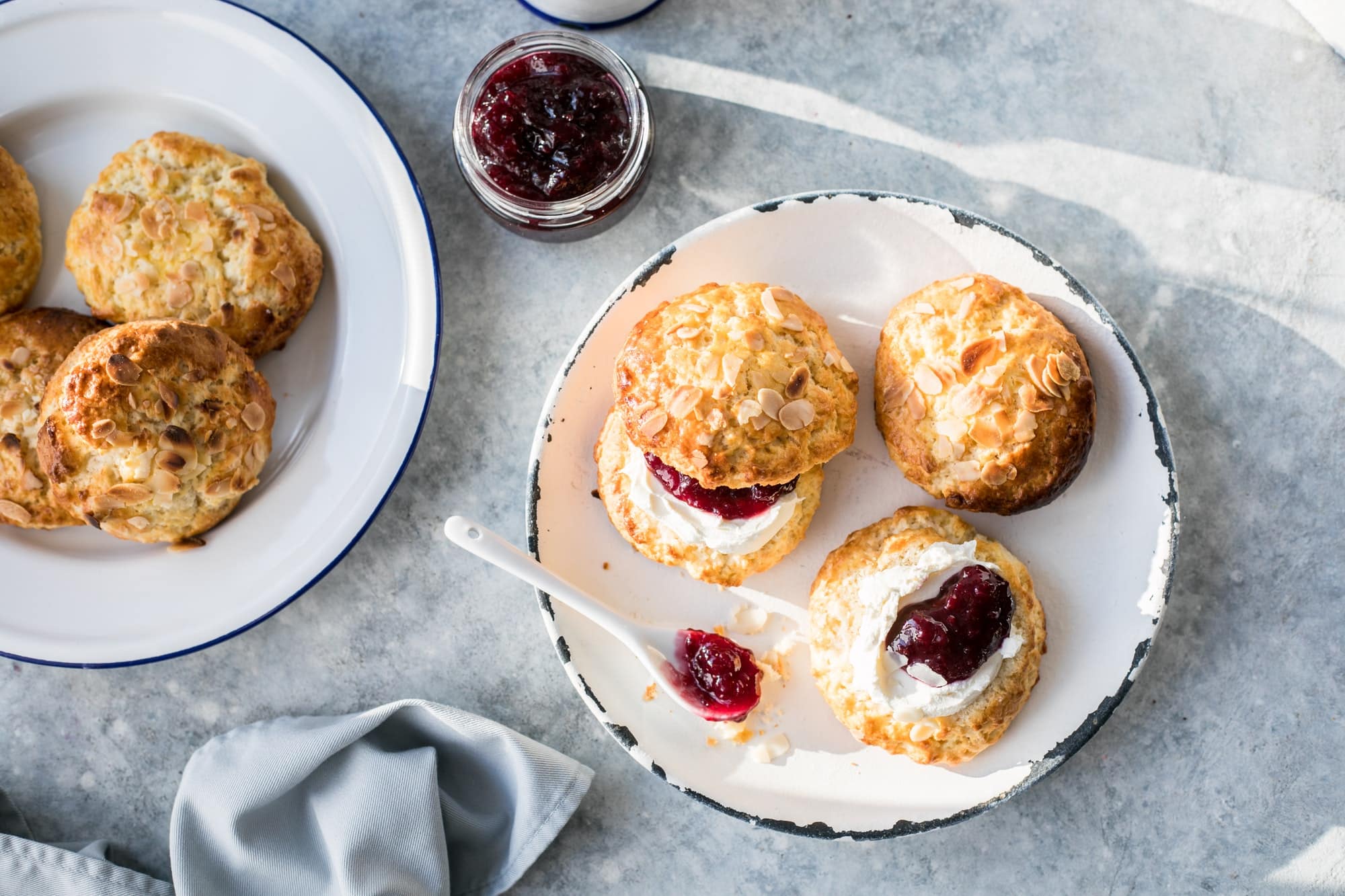When it comes to British traditions, few things are as quintessentially English as indulging in a warm scone laden with clotted cream and jam during afternoon tea. The delightful combination of a freshly baked scone, sumptuous clotted cream, and sweet jam is enough to make anyone’s mouth water. But, what’s the key to crafting the perfect English afternoon tea scone? Let’s delve into the world of scones, cream, and tea to uncover the secrets behind this beloved British indulgence.
Begin with the Basics: The Scone Dough
The foundation of any delicious scone is the dough. This is where the magic begins. Making scone dough is a delicate process that requires precision, patience, and a few fundamental ingredients: flour, butter, sugar, and baking powder.
Cela peut vous intéresser : How to Craft a Gourmet Elderflower and Strawberry Jelly with Fresh Berries?
In terms of flour, it’s critical to use a high-quality, all-purpose variety for a light and tender scone. The butter should be cold, as this helps to create a flaky texture in the final product. Sugar adds a hint of sweetness to the dough, and baking powder is essential for leavening, helping the scones to rise in the oven.
When mixing these ingredients, it’s crucial to avoid overworking the dough. Gentle handling will ensure that your scones are soft and crumbly, rather than hard and dense. Once you’ve formed your dough, cut it into rounds and bake for about 15 to 20 minutes, until the scones are golden brown.
Sujet a lire : How to Make a Gourmet Fresh Peach Bellini with Prosecco?
Elevating the Experience: The Clotted Cream
The next component of the perfect afternoon tea scone is the clotted cream. Originating from the English counties of Devon and Cornwall, clotted cream, or "Cornish cream," is a thick, rich, and slightly sweetened cream with a texture that falls somewhere between whipped cream and butter. Its name comes from the "clots" or "clouts" that form on the surface as it slowly cooks.
Preparing this cream can be quite time-consuming, as it requires gently heating unpasteurized cow’s milk for several hours, then leaving it in a cool place overnight. The result is a luscious, velvety cream with a distinctive golden crust, perfect for slathering on warm scones.
Don’t Forget the Jam
While clotted cream is a star player in the English afternoon tea, it is the pairing with jam that truly amplifies the experience. Traditionally, British recipes call for strawberry jam, but really any fruit jam that you enjoy will suit perfectly.
Jam adds a fruity, tangy contrast to the cream’s richness and the scone’s savory notes. When layering the cream and jam on your scones, be sure to spread generously. The English do not skimp on these delicious toppings, and neither should you!
The Art of Pairing with Tea
Of course, no English afternoon tea scone would be complete without the perfect cup of tea. Choosing the right type of tea can enhance the flavors of your scone, cream, and jam.
Black tea, with its robust and full-bodied flavor, is a traditional choice for afternoon tea. Darjeeling and Earl Grey are particularly popular options. These teas have a strong enough flavor to stand up to the rich scone and cream, but also contain subtle citrusy notes that complement the sweetness of the jam.
Time, Patience, and Love: The Secrets to Perfect Afternoon Tea Scones
Above all, time, patience, and love are the most essential ingredients in crafting the perfect English afternoon tea scone. These aren’t fast food items that can be rushed. Each component, from the scone dough to the clotted cream and jam, requires careful preparation.
So, take your time. Savor the process of baking the scones, of slowly heating the cream, of choosing the perfect jam. Enjoy the aroma of fresh-baked scones filling your kitchen, the creamy texture of the clotted cream on your tongue, the sweetness of the jam as it mingles with the scone and cream.
And when you finally sit down to enjoy your English afternoon tea, remember: this is more than just a snack. It’s a tradition, a moment of indulgence, a slice of English heritage served up on a plate. So, make every bite count.
Precision in Baking: The Scone Recipe
Before you start, preheat your oven to 220C – 200C fan – gas 7 and line a baking sheet with baking parchment. The key to crafting the perfect English scone lies in the balance of the ingredients and the baking process. Start by placing 350g self-raising flour into a large bowl with 1⁄4 tsp salt and 1 tsp baking powder, then mix. Add 85g of cubed butter, then rub in with your fingers until the mix looks like fine crumbs. Stir in 3 tbsp caster sugar.
Next, warm 175ml milk in the microwave for about 30 secs until warm, but not hot. Add 1 tsp vanilla extract and a squeeze of lemon juice, then set aside for a moment. Put a baking sheet in the oven. Make a well in the dry mix, then add the liquid and combine it quickly with a cutlery knife. Scatter some flour onto the work surface and tip the dough out. Dredge the dough and your hands with a little more flour, then fold the dough over 2-3 times until it’s a little smoother.
Pat into a round about 4cm deep, then take a 5cm cutter (smooth-edged cutters tend to cut more cleanly, giving a better rise) and dip it into some flour. Plunge into the dough, then repeat until you have four scones. Press what’s left of the dough back into a round to cut out another four. Brush the tops with a beaten egg, then carefully place onto the hot baking tray. Bake for 10 minutes time minutes or until risen and golden on the top.
Hosting the perfect tea party: Afternoon Tea Scones
Now that you have your delightful homemade scones, it’s time to host the perfect English tea party. First, allow your scones to cool just a bit so they’re warm, not hot. Slice them in half and slather a good dollop of clotted cream on one side. Next, spread a layer of strawberry jam on the other half.
The sequence of cream and jam has been a subject of debate; whether the cream goes on first followed by the jam, or vice versa, depends on whether you’re in Devon or Cornwall! However you choose to layer, the combination of the two is heavenly.
Arrange your scones attractively on a cake stand or serving plate, and serve alongside pots of clotted cream and strawberry jam so your guests can add more if they wish. Remember to also serve a pot of freshly brewed tea, preferably a robust English tea like Darjeeling or Earl Grey.
The quintessential afternoon tea is not just about the food and drink, but also the atmosphere. Use your finest china, lay out a crisp tablecloth, and perhaps add some fresh flowers for a touch of elegance. Encourage your guests to linger, enjoy their tea and scones, and most importantly, to relax.
Conclusion: The Joy of English Scones
In conclusion, crafting a perfect English afternoon tea scone with clotted cream isn’t just a culinary endeavor – it’s a labor of love. From the careful preparation of the scone dough to the slow creation of the clotted cream, each step needs your attention and care. And when served with a pot of hot tea, it becomes a meal to savor and an experience to remember.
The magic of the perfect cream tea is more than just the delicious taste of the scones, the richness of the cream, and the sweet tang of the jam. It’s in the tradition, the calmness of the afternoon, and the joy of sharing good food with good company. So, put on the kettle, dust off your best china, and enjoy the delightful journey of creating and savoring your own English afternoon tea scones.






